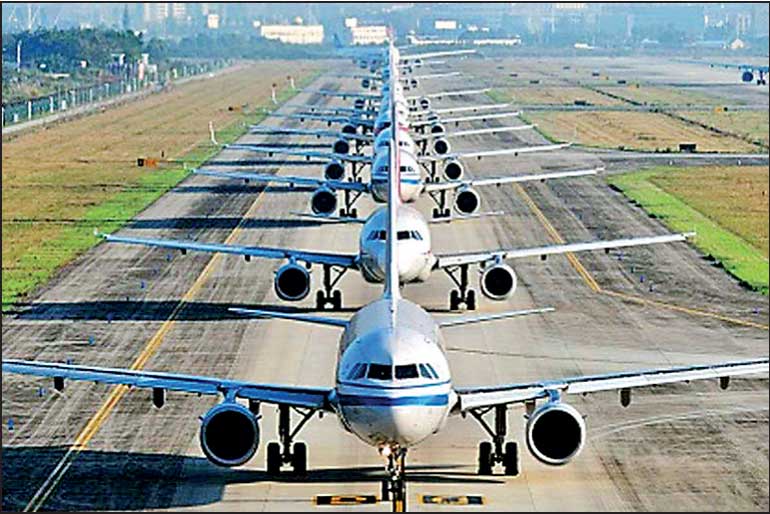Tuesday Apr 22, 2025
Tuesday Apr 22, 2025
Monday, 28 June 2021 00:00 - - {{hitsCtrl.values.hits}}

The aviation industry is littered with innovative and capable designs that made it as far as being manufactured and entering service, only to fail commercially
 The airline industry as we know it today began with a piece of legislation known as the Air Mail Act of 1925, which was legislated by the United States Congress to allow private contractors to carry airmail. The primitive, frail aircraft of the time could barely transport a handful of passengers, but with a guaranteed source of revenue, a landmark period of innovation began.
The airline industry as we know it today began with a piece of legislation known as the Air Mail Act of 1925, which was legislated by the United States Congress to allow private contractors to carry airmail. The primitive, frail aircraft of the time could barely transport a handful of passengers, but with a guaranteed source of revenue, a landmark period of innovation began.
In less than 10 years’ time, US designers had built efficient passenger aircraft such as the Boeing Model 247 and immortal Douglas DC-3, thus creating an entirely new business: the passenger airline. A pause in airline growth during the Second World War, as resources were poured into the war effort, resulted in a boom after that conflict ended. 25 years of advancement in aircraft development followed and saw airline routes established all over the world. The ‘jet age’ transformed the planet in many ways both good and bad, with bigger and faster aircraft constantly being produced, culminating in the classic Boeing 747 and Anglo-French Aérospatiale/BAC Concorde in the nineteen sixties.
The first bust
The first stumble in almost 40 years of relentless growth came with the oil crisis of the 1970s, when an unprecedented surge in the cost of fuel saw many airlines enter bankruptcy as costs spiralled out of control. Air travel dropped dramatically and older aircraft were prematurely retired as the industry went through fundamental changes. Efficiency and cost control became vital requirements, as fuel bills went from an almost unnoticed slice of the budget to exceed 30% of total costs.
One of the first victims of this paradigm shift was the abandonment of supersonic flight as a commercial venture. Boeing shut down their project to build an SST (supersonic transport), and the USA banned civil aircraft from supersonic flight over its landmass. The Soviet Union and Anglo-French consortiums separately went ahead with designing and flying SSTs, but the Russian Tupolev Tu-144 was involved in a disastrous accident at an air show and never flew again.
The European Concorde did fly for many years, but just 10 examples were built, with British Airways and Air France being the only operators. Development costs ran into the billions, and that investment had to be completely written off, though the aircraft were profitable (at an operational level) over limited trans-Atlantic routes. A cruise speed of Mach 2.2 (more than twice the speed of sound) meant that travel time was half that of conventional aircraft, so Concorde service was very popular with wealthy businesspeople, luxury leisure passengers and celebrities, including one foreign minister of a small South Asian island-nation who was frequently seen on board Concorde in the 1980s.
The worst bust
The global slowdown caused by the COVID-19 pandemic has been the worst in the short history of commercial airlines. Even the most optimistic airline managers now accept that the industry has drastically changed, and that a partial worldwide recovery is unlikely until summer 2022 at the earliest.
Yet, despite the looming bankruptcies of almost every airline in the world, a number of optimists have been promoting SSTs yet again. Even the usually conservative US Air Force is considering plans for a supersonic addition to its Presidential fleet of aircraft. Not to be outdone, Russia’s President Putin has proposed an adapted supersonic bomber design as an executive jet catering to Russian oligarchs.
Competing designs
Currently there are several companies competing to make a 21st century SST a reality. The leading contender is Boom Technologies, who recently announced a provisional order from United Airlines for its Overture design which will cruise at Mach 1.7, more than twice the speed of conventional aircraft. Virgin Atlantic and Japan Airlines have already placed orders for it, and the aircraft is due to undergo test flying by 2026, with the first commercial model slated for delivery in 2029.
Aerion, a rival company has declared that its supersonic aircraft, a small 12-seat jet named the AS2, capable of attaining Mach 1.4, will fly in 2023. Furthermore, Aerion claimed that the later and larger AS3 will be even faster (at four times the speed of sound), and expected to be in production by the end of this decade. However, the company announced in May 2021 that it had ‘funding shortcomings’, and is unlikely to build an aircraft in the near future.
Another Boston-based company, Spike Aerospace, also has plans for a 12-18-passenger jet which will cruise at Mach 1.6, but hasn’t offered a timeline for the project.
Will a supersonic transport be a commercial reality?
Designing, testing, certifying and building a modern airplane is a task that absorbs billions of dollars with little guarantee of profit. The most recent privately funded initiative to build a new passenger aircraft, Bombardier’s C-series, burned an estimated $ 6 billion before the rights to the aircraft were sold to Airbus for a meagre $ 1.
A not dissimilar aircraft, the Sukhoi Superjet built by Russia’s United Aircraft Corporation with state funding, was successfully designed, certified (by both Russian and European civil aviation authorities) and produced, but has failed dismally in airline service, with a poor safety record (three fatal accidents) and erratic dispatch reliability.
To bring a supersonic aircraft to airline service within a decade would be a phenomenal achievement, especially when it is considered that engines of a suitable type and capability required have not even been designed yet, let alone tested (Rolls-Royce, who built the engines for Concorde, are part of the Boom project. General Electric, with an extensive track-record of building advanced military powerplants was slated to design the engine for the Aerion).
The aviation industry is littered with innovative and capable designs that made it as far as being manufactured and entering service, only to fail commercially. Airbus’s flagship, the mighty A380, is the latest in a long line of wonderful machines that were destroyed by the brutal market realities of the airline world.
An operating and affordable supersonic passenger transport would be an amazing development. This writer bitterly regrets the missed opportunities to fly in Concorde. A chance to be a passenger in a future SST is a wonderful dream, but I very much doubt it will be a reality in my lifetime.
Discover Kapruka, the leading online shopping platform in Sri Lanka, where you can conveniently send Gifts and Flowers to your loved ones for any event including Valentine ’s Day. Explore a wide range of popular Shopping Categories on Kapruka, including Toys, Groceries, Electronics, Birthday Cakes, Fruits, Chocolates, Flower Bouquets, Clothing, Watches, Lingerie, Gift Sets and Jewellery. Also if you’re interested in selling with Kapruka, Partner Central by Kapruka is the best solution to start with. Moreover, through Kapruka Global Shop, you can also enjoy the convenience of purchasing products from renowned platforms like Amazon and eBay and have them delivered to Sri Lanka.
Discover Kapruka, the leading online shopping platform in Sri Lanka, where you can conveniently send Gifts and Flowers to your loved ones for any event including Valentine ’s Day. Explore a wide range of popular Shopping Categories on Kapruka, including Toys, Groceries, Electronics, Birthday Cakes, Fruits, Chocolates, Flower Bouquets, Clothing, Watches, Lingerie, Gift Sets and Jewellery. Also if you’re interested in selling with Kapruka, Partner Central by Kapruka is the best solution to start with. Moreover, through Kapruka Global Shop, you can also enjoy the convenience of purchasing products from renowned platforms like Amazon and eBay and have them delivered to Sri Lanka.